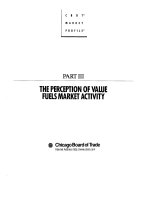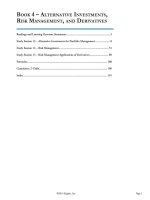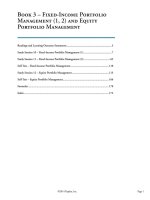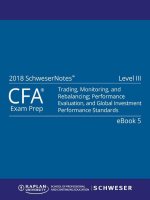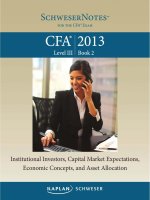sample level 3 wiley study guide vol 3
Bạn đang xem bản rút gọn của tài liệu. Xem và tải ngay bản đầy đủ của tài liệu tại đây (4.38 MB, 35 trang )
2 0 18
CFA® EXAM REVIEW
1
W IL E Y
Wiley Study Guide for 2018
Level III CFA Exam Review
Complete Set
Thousands of candidates from more than 100 countries have relied on these Study Guides
to pass the CFA® Exam. Covering every Learning Outcome Statement (LOS) on the exam,
these review materials are an invaluable tool for anyone who wants a deep-dive review of
all the concepts, formulas, and topics required to pass.
Wiley study materials are produced by expert CFA charterholders, CFA Institute members,
and investment professionals from around the globe. For more information, contact us at
info @efficientleaming.com.
Wiley Study Guide for 2018
Level III CFA Exam Review
Wi l
ey
Copyright © 2018 by John Wiley & Sons, Inc. All rights reserved.
Published by John Wiley & Sons, Inc., Hoboken, New Jersey.
Published simultaneously in Canada.
No part of this publication may be reproduced, stored in a retrieval system, or transmitted in any
form or by any means, electronic, mechanical, photocopying, recording, scanning, or otherwise,
except as permitted under Section 107 or 108 of the 1976 United States Copyright Act, without
either the prior written permission of the Publisher, or authorization through payment of the
appropriate per-copy fee to the Copyright Clearance Center, Inc., 222 Rosewood Drive, Danvers,
MA 01923, (978) 750-8400, fax (978) 646-8600, or on the Web at www.copyright.com. Requests
to the Publisher for permission should be addressed to the Permissions Department, John Wiley &
Sons, Inc., I l l River Street, Hoboken, NJ 07030, (201) 748-6011, fax (201) 748-6008, or online
at />Limit of Liability/Disclaimer of Warranty: While the publisher and author have used their best
efforts in preparing this book, they make no representations or warranties with respect to the
accuracy or completeness of the contents of this book and specifically disclaim any implied
warranties of merchantability or fitness for a particular purpose. No warranty may be created or
extended by sales representatives or written sales materials. The advice and strategies contained
herein may not be suitable for your situation. You should consult with a professional where
appropriate. Neither the publisher nor author shall be liable for any loss of profit or any other
commercial damages, including but not limited to special, incidental, consequential, or other
damages.
For general information on our other products and services or for technical support, please contact
our Customer Care Department within the United States at (800) 762-2974, outside the United
States at (317) 572-3993 or fax (317) 572-4002.
Wiley publishes in a variety of print and electronic formats and by print-on-demand. Some
material included with standard print versions of this book may not be included in e-books or in
print-on-demand. If this book refers to media such as a CD or DVD that is not included in the
version you purchased, you may download this material at . For
more information about Wiley products, visit www.wiley.com.
Required CFA® Institute disclaimer:
“CFA® and Chartered Financial Analyst® are trademarks owned by CFA Institute. CFA Institute
(formerly the Association for Investment Management and Research) does not endorse, promote,
review or warrant the accuracy of the products or services offered by John Wiley & Sons, Inc.”
Certain materials contained within this text are the copyrighted property of CFA Institute. The
following is the copyright disclosure for these materials:
“Copyright 2016, CFA Institute. Reproduced and republished with permission from CFA Institute.
All rights reserved.”
These materials may not be copied without written permission from the author. The unauthorized
duplication of these notes is a violation of global copyright laws and the CFA Institute Code of
Ethics. Your assistance in pursuing potential violators of this law is greatly appreciated.
Disclaimer: John Wiley & Sons, Inc.’s study materials should be used in conjunction with
the original readings as set forth by CFA Institute in the 2017 CFA Level III Curriculum. The
information contained in this book covers topics contained in the readings referenced by CFA
Institute and is believed to be accurate. However, their accuracy cannot be guaranteed.
ISBN 978-1-119-43611-9 (ePub)
ISBN 978-1-119-43610-2 (ePDF)
Contents
About the Authors
xi
Wiley Study Guide for 2018 Level III CFA Exam
Volume 1: Ethical and Professional Standards & Behavioral Finance
Study Session 1: Code of Ethics and Standards of Professional Conduct
Reading 1: Code of Ethics and Standards of Professional Conduct
Lesson 1: Code of Ethics and Standards of Professional Conduct
Reading 2: Guidance for Standards l-VII
Lesson 1: Standard I: Professionalism
Lesson 2: Standard II: Integrity of Capital Markets
Lesson 3: Standard III: Duties to Clients
Lesson 4: Standard IV: Duties to Employers
Lesson 5: Standard V: Investment Analysis, Recommendations, and Actions
Lesson 6: Standard VI: Conflicts of Interest
Lesson 7: Standard VII: Responsibilities as a CFA Institute Member or CFA Candidate
3
3
9
9
36
46
70
84
97
107
Study Session 2: Ethical and Professional Standards in Practice
Reading 3: Application of the Code and Standards
Lesson 1: Ethical and Professional Standards in Practice, Part 1: The Consultant
Lesson 2: Ethical and Professional Standards in Practice, Part 2: Pearl Investment
Management
Reading 4: Asset Manager Code of Professional Conduct
Lesson 1: Asset Manager Code of Professional Conduct
119
119
120
121
121
Study Session 3: Behavioral Finance
Reading 5: The Behavioral Finance Perspective
Lesson 1: Behavioral versus Traditional Perspectives
Lesson 2: Decision Making
Lesson 3: Perspectives on Market Behavior and Portfolio Construction
131
131
136
140
Reading 6: The Behavioral Biases of Individuals
Lesson 1: Cognitive Biases
Lesson 2: Emotional Biases
Lesson 3: Investment Policy and Asset Allocation
147
148
154
159
© 2 0 1 8 W iley
©
CONTENTS
Reading 7: Behavioral Finance and Investment Processes
Lesson 1:The Uses and Limitations of Classifying Investors into Types
Lesson 2: How Behavioral Factors Affect Advisor-Client Relations
Lesson 3: How Behavioral Factors Affect Portfolio Construction
Lesson 4: Behavioral Finance and Analyst Forecasts
Lesson 5: How Behavioral Factors Affect Committee Decision Making
Lesson 6: How Behavioral Finance Influences Market Behavior
165
165
168
169
172
178
179
Wiley Study Guide for 2018 Level III CFA Exam
Volume 2: Private Wealth Management & Institutional Investors
Study Session 4: Private Wealth Management (1)
Reading 8: Managing Individual Investor Portfolios
Lesson 1: Investor Characteristics: Situational and Psychological Profiling
Lesson 2: Individual IPS: Return Objective Calculation
Lesson 3: Individual IPS: Risk Objective
Lesson 4: Individual IPS: The Five Constraints
Lesson 5: A Complete Individual IPS
Lesson 6: Asset Allocation Concepts: The Process of Elimination
Lesson 7: Monte Carlo Simulation and Personal Retirement Planning
Reading 9: Taxes and Private Wealth Management in a Global Context
Lesson 1: Overview of Global Income Tax Structures
Lesson 2: After-Tax Accumulations and Returns forTaxable Accounts
Lesson 3: Types of Investment Accounts and Taxes and Investment Risk
Lesson 4: Implications for Wealth Management
Reading 10: Domestic Estate Planning: Some Basic Concepts
Lesson 1: Basic Estate Planning Concepts
Lesson 2: Core Capital and Excess Capital
Lesson 3: Transferring Excess Capital
Lesson 4: Estate Planning Tools
Lesson 5: Cross-Border Estate Planning
3
3
6
7
8
10
18
20
21
21
23
31
34
39
39
42
46
51
53
Study Session 5: Private Wealth Management (2)
©
Reading 11: Concentrated Single-Asset Positions
Lesson 1: Concentrated Single-Asset Positions: Overview and Investment Risks
Lesson 2: General Principles of Managing Concentrated Single-Asset Positions
Lesson 3: Managing the Risk of Concentrated Single-Stock Positions
Lesson 4: Managing the Risk of Private Business Equity
Lesson 5: Managing the Risk of Investment in Real Estate
59
59
60
66
71
74
Reading 12: Risk Management for Individuals
Lesson 1: Human Capital and Financial Capital
Lesson 2: Seven Financial Stages of Life
Lesson 3: A Framework for Individual Risk Management
Lesson 4: Life Insurance
Lesson 5: Other Types of Insurance
Lesson 6: Annuities
Lesson 7: Implementation of Risk Management for Individuals
77
77
78
80
83
88
91
95
© 2 0 1 8 W iley
CONTENTS
Study Session 6: Portfilio Management for Institutional Investors
Reading 13: Managing Institutional Investor Portfolios
Lesson 1: Institutional IPS: Defined Benefit (DB) Pension Plans
Lesson 2: Institutional IPS: Foundations
Lesson 3: Institutional IPS: Endowments
Lesson 4: Institutional IPS: Life Insurance and
Non-Life Insurance Companies (Property and Casualty)
Lesson 5: Institutional IPS: Banks
103
103
111
115
117
120
Wiley Study Guide for 2018 Level III CFA Exam
Volume 3: Economic Analysis, Asset Allocation, Equity & Fixed Income Portfolio Management
Study Session 7: Applications of Economic Analysis to Portfolio Management
Reading 14: Capital Market Expectations
3
Lesson 1: Organizing the Task: Framework and Challenges
3
Lesson 2: Tools for Formulating Capital Market Expectations,Part 1: Formal Tools
8
Lesson 3: Tools for Formulating Capital Market Expectations,Part 2: Survey and
Panel Methods and Judgment
13
Lesson 4: Economic Analysis, Part 1: Introduction and Business Cycle Analysis
19
Lesson 5: Economic Analysis, Part 2: Economic Growth Trends, Exogenous Shocks, and
International Interactions
27
Lesson 6: Economic Analysis, Part 3: Economic Forecasting
30
Lesson 7: Economic Analysis, Part 4: Asset Class Returns andForeign Exchange Forecasting 33
Reading 15: Equity Market Valuation
39
Lesson 1: Estimating a Justified P/E Ratio and Top-Down and Bottom-Up Forecasting
39
Lesson 2: Relative Value Models
46
Study Session 8: Asset Allocation and Related Decisions in Portfolio Management (1)
Reading 16: Introduction to Asset Allocation
Lesson 1: Asset Allocation in the Portfolio Construction Process
Lesson 2: The Economic Balance Sheet and Asset Allocation
Lesson 3: Approaches to Asset Allocation
Lesson 4: Strategic Asset Allocation
Lesson 5: Implementation Choices
Lesson 6: Strategic Considerations for Rebalancing
Reading 17: Principles of Asset Allocation
Lesson 1: The Traditional Mean-Variance Optimization (MVO) Approach
Lesson 2: Monte Carlo Simulation and Risk Budgeting
Lesson 3: Factor-Based Asset Allocation
Lesson 4: Liability-Relative Asset Allocation
Lesson 5: Goal-Based Asset Allocation, Heuristics, Other Approaches to Asset Allocation,
and Portfolio Rebalancing
53
53
54
55
57
64
65
67
67
70
71
72
75
Study Session 9: Asset Allocation and Related Decisions in Portfolio Management (2)
Reading 18: Asset Allocation with Real-World Constraints
Lesson 1: Constraints in Asset Allocation
Lesson 2: Asset Allocation for the Taxable Investor
© 2 0 1 8 W iley
81
81
84
CONTENTS
Lesson 3: Altering or Deviating from the Policy Portfolio
Lesson 4: Behavioral Biases in Asset Allocation
Reading 19: Currency Management: An Introduction
Lesson 1: Review of Foreign Exchange Concepts
Lesson 2: Currency Risk and Portfolio Return and Risk
Lesson 3: Currency Management: Strategic Decisions
Lesson 4: Currency Management: Tactical Decisions
Lesson 5: Tools of Currency Management
Lesson 6: Currency Management for Emerging Market Currencies
Reading 20: Market Indexes and Benchmarks
Lesson 1: Distinguishing between a Benchmark and a Market Index and
Benchmark Uses and Types
Lesson 2: Market Index Uses and Types
Lesson 3: Index Weighting Schemes: Advantages and Disadvantages
85
87
89
89
95
98
101
104
112
113
113
117
119
Study Session 10: Fixed-Income Portfolio Management (1)
Reading 21: Introduction to Fixed-Income Portfolio Management
Lesson 1: Roles of Fixed Income Securities in Portfolios
Lesson 2: Fixed Income Mandates
Lesson 3: Bond Market Liquidity
Lesson 4: Components of Fixed Income Return
Lesson 5: Leverage
Lesson 6: Fixed Income Portfolio Taxation
Reading 22: Liability-Driven and Index-Based Strategies
Lesson 1: Liability-driven Investing
Lesson 2: Managing Single and Multiple Liabilities
Lesson 3: Risks in Managing a Liability Structure
Lesson 4: Liability Bond Indexes
Lesson 5: Alternative Passive Bond Investing
Lesson 6: Liability Benchmarks
Lesson 7: Laddered Bond Portfolios
127
127
129
133
135
137
140
143
143
144
147
148
148
149
149
Study Session 11: Fixed-Income Portfolio Management (2)
Reading 23: Yield Curve Strategies
Lesson 1: Foundational Concepts for Yield Curve Management
Lesson 2: Yield Curve Strategies
Lesson 3: Formulating a Portfolio Postioning Strategy for a Given Market View
Lesson 4: A Framework for Evaluating Yield Curve Trades
Reading 24: Fixed-Income Active Management: Credit Strategies
Lesson 1: Investment-Grade and High-Yield Corporate Bond Portfolios
Lesson 2: Credit Spreads
Lesson 3: Credit Strategy Approaches
Lesson 4: Liquidity Risk and Tail Risk in Credit Portfolios
Lesson 5: International Credit Portfolios
Lesson 6: Structured Financial Instruments
153
153
155
161
167
169
169
172
175
185
189
191
© 2 0 1 8 W iley
CONTENTS
Study Session 12: Equity Portfolio Management
Reading 25: Equity Portfolio Management
Lesson 1:The Role of the Equity Portfoli and Approaches to Equity Investing
Lesson 2: Passive Equity Investing
Lesson 3: Active Equity Investing
Lesson 4: Semiactive Equity Investing
Lesson 5: Managing a Portfolio of Managers
Lesson 6: Identifying, Selecting, and Contracting with Equity Portfolio Managers
Lesson 7: Distressed Securities
197
197
198
204
215
218
222
223
Wiley Study Guide for 2018 Level III CFA Exam
Volume 4: Alternative Investments, Risk Management, & Derivatives
Study Session 13: Alternative Investments for Portfolio Management
Reading 26: Alternative Investments for Portfolio Management
Lesson 1: Alternative Investments: Definitions, Similarities, and Contrasts
Lesson 2: Real Estate
Lesson 3: Private Equity/Venture Capital
Lesson 4: Commodity Investments
Lesson 5: Hedge Funds
Lesson 6: Managed Futures
Lesson 7: Distressed Securities
3
3
5
9
16
21
30
32
Study Session 14: Risk Management
Reading 27: Risk Management
Lesson 1: Risk Management as a Process and Risk Governance
Lesson 2: Identifying Risk
Lesson 3: Measuring Risk: Value at Risk (VaR)
Lesson 4: Measuring Risk: VaR Extensions and Stress Testing
Lesson 5: Measuring Risk: Credit Risk
Lesson 6: Managing Risk
39
39
40
44
52
53
60
Study Session 15: Risk Management Applications of Derivatives
Reading 28: Risk Management Applications of Forward and Futures Strategies
Lesson 1: Strategies and Applications for Managing Equity Market Risk
Lesson 2: Asset Allocation with Futures
Lesson 3: Strategies and Applications for Managing Foreign Currency Risk
Reading 29: Risk Management Applications of Option Strategies
Lesson 1: Options Strategies for Equity Portfolios
Lesson 2: Interest Rate Option Strategies
Lesson 3: Option Portfolio Risk Management Strategies
Reading 30: Risk Management Applications of Swap Strategies
Lesson 1: Strategies and Applications for Managing Interest Rate Risk
Lesson 2: Strategies and Applications for Managing Exchange Rate Risk
Lesson 3: Strategies and Applications for Managing Equity Market Risk
Lesson 4: Strategies and Applications Using Swaptions
© 2 0 1 8 W iley
65
65
74
83
89
89
103
116
121
121
137
148
153
0
CONTENTS
Wiley Study Guide for 2018 Level III CFA Exam
Volume 5: Trading, Monitoring and Rebalancing, Performance Evaluation,
& Global Investment Performance Standards
Study Session 16: Trading, Monitoring, and Rebalancing
Reading 31: Execution of Portfolio Decisions
Lesson 1: The Context of Trading: Market Microstructure
Lesson 2: The Costs of Trading
Lesson 3:Types ofTraders and Their Preferred OrderTypes
Lesson 4: Trade Execution Decisions and Tactics and Serving the Client's Interests
Reading 32: Monitoring and Rebalancing
Lesson 1: Monitoring for IPS Changes (Individual and Institutional)
Lesson 2: Rebalancing the Portfolio
Lesson 3: The Perold-Sharpe Analysis of Rebalancing Strategies
3
3
10
15
17
25
25
32
35
Study Session 17: Performance Evaluation
Reading 33: Evaluating Portfolio Performance
Lesson 1: Performance Measurement
Lesson 2: Benchmarks
Lesson 3: Performance Attribution (4 Models)
Lesson 4: Performance Appraisal
Lesson 5: The Practice of Performance Evaluation
41
41
49
55
66
71
Study Session 18: Global Investment Performance Standards
Reading 34: Overview of the Global Investment Performance Standards
Lesson 1: Background of the GIPS Standards
Lesson 2: Fundamentals of Compliance
Lesson 3: Input Data
Lesson 4: Return Calculation Methodologies
Lesson 5: Composite Construction Lesson
Lesson 6: Disclosure, Presentation, and Reporting
Lesson 7: Real Estate, Private Equity, and Wrap Fee/Separately Managed Accounts
Lesson 8: Valuation Principles and Advertising Guidelines
Lesson 9: Verification and Other Issues
©
75
75
76
78
79
85
89
96
102
104
©2018 Wiley
ABOUTTHE AUTHORS
Wiley’s Study Guides are written by a team of highly qualified CFA charterholders
and leading CFA instructors from around the globe. Our team of CFA experts work
collaboratively to produce the best study materials for CFA candidates available today.
Wiley’s expert team of contributing authors and instmctors is led by Content Director Basit
Shajani, CFA. Basit founded online education start-up Elan Guides in 2009 to help address
CFA candidates’ need for better study materials. As lead writer, lecturer, and curriculum
developer, Basit’s unique ability to break down complex topics helped the company grow
organically to be a leading global provider of CFA Exam prep materials. In January 2014,
Elan Guides was acquired by John Wiley & Sons, Inc., where Basit continues his work
as Director of CFA Content. Basit graduated magna cum laude from the Wharton School
of Business at the University of Pennsylvania with majors in finance and legal studies.
He went on to obtain his CFA charter in 2006, passing all three levels on the first attempt.
Prior to Elan Guides, Basit ran his own private wealth management business. He is a past
president of the Pakistani CFA Society.
There are many more expert CFA charterholders who contribute to the creation of
Wiley materials. We are thankful for their invaluable expertise and diligent work.
To learn more about Wiley’s team of subject matter experts, please visit:
www. efficientleaming.com/cfa/why-wiley/.
© 2 0 1 8 W iley
©
St u d y S essio n 7: A ppl ic a t io n s o f E c o n o mic
A n a l y sis t o Po r t f o l io M a n a g emen t
© 2 0 1 8 W tley
CAPITAL MARKET EXPECTATIONS
R e a d i n g 1 4 : Ca p i t
al
Ma r
ket
Ex pe c
t a t io n s
Time to complete: 2 to 3 hours
Reading summary: This is one of the longest readings in the entire CFA Curriculum at
Level III, so plan your time accordingly. The focus of the first portion of the reading is
on formal tools to determine long-term expectations, mainly for returns. Then, short- and
long-term economic growth forecasting and analysis are explored. The reading then
examines how various asset classes perform at different stages of the business and inflation
cycles.
LESSON 1: ORGANIZING THE TASK: FRAMEWORK AND CHALLENGES
LOS I4a: Discuss the role of, and a framework for, capital market
expectations in the portfolio management process. Vol 3, pp 6-13
LEARNING OBJECTIVES
The portfolio management process begins with understanding the client’s objectives and
constraints, which are documented in the investment policy statement (IPS). This clientspecific information is then combined with the portfolio manager’s expectations about the
long-term performance of asset classes to establish a unique strategic asset allocation. But
how do managers form their capital market expectations? That is the question addressed by
this reading.
After studying this material, the candidate should be able to:
1.
2.
3.
4.
Explain how capital market expectations fit within the portfolio management
process;
Describe analytical tools and models used to develop capital market expectations;
Discuss the implications of the business cycle and economic policy for capital
market expectations;
Explain how macroeconomic variables like inflation, interest rates, and exchange
rates are forecast and how they influence capital market expectations.
A SYSTEMATIC APPROACH
The strategic asset allocation represents the base case, or normal state, partitioning of a
portfolio among the various asset classes available in the investment universe. Each asset
class (e.g., stocks, bonds, real estate, etc.) has unique risk and return characteristics that
respond to changing economic conditions. So in order to ascertain which asset classes
belong in a particular investor’s portfolio and in what proportion, the manager must have
some idea of what the prevailing economic environment might look like and how asset
classes might react under those conditions. These insights are collectively referred to as the
manager’s capital market expectations.
© 2 0 1 8 W iley
©
CAPITAL MARKET EXPECTATIONS
Given the vast amount of data available to asset managers, developing capital market
expectations is best implemented using a systematic approach. In a general framework, the
manager must address each of the following functions:
•
•
•
Data collection, analysis, and interpretation of output.
Deriving conclusions that lead to forecasts of expected returns, risk, and
correlations.
Monitoring, evaluating performance, and adjusting the process to improve future
performance.
The process of setting capital market expectations is usually considered beta research,
which emphasizes systematic risk of broad asset classes (e.g., equities, fixed income, and
real estate). The research takes a macroeconomic perspective that uses the same inputs
(e.g., interest rates, inflation, GDP growth, etc.) to develop expectations that are used to
design a strategic asset allocation. Alpha research is an investment-specific approach
that seeks to earn excess risk-adjusted returns, which is more closely related to security
selection.
Steps in Formulating Capital Market Expectations
Step 1: Specify the final objectives o f the process and the relevant time period. The purpose
of this step is to limit the scope of the research. With so much information available, the
manager cannot consider everything under the sun. For example, if the client’s IPS limits
acceptable asset classes to only domestic stocks and bonds, there is no need to research
emerging-market real estate or commodity futures. Managers often complete this step by
drafting a set of questions to be answered, which helps to focus their efforts.
Step 2: Review past performance and conditions. While the past is not necessarily
indicative of the future, it is a logical place to start, with the understanding that relation
that held in the past are susceptible to change.
Step 3: Define methods and models. Establishing the methodology early in the process will
help determine what data is required.
Step 4: Collect data. When considering data sources, the manager must evaluate their
timeliness, accuracy, and reliability.
Step 5: Apply analytical techniques, models, and judgment to interpret results. Particular
attention should be paid to the assumptions underlying models, the consistency with which
data is used, and any conflicts that might challenge the plausibility of output.
Step 6: Draw conclusions. Here the manager determines and documents his or her
expectations that will be used in establishing the portfolio’s strategic asset allocation.
Step 7: Evaluate results and adjust. Actual results are compared to previous expectations
to assess the level of accuracy that the expectations-setting process is delivering. Good
forecasts are:
ã
ã
ã
â
Unbiased, objective, and well researched;
Efficient, minimizing the magnitude of forecast errors; and
Internally consistent.
© 2 0 1 8 W iley
CAPITAL MARKET EXPECTATIONS
LOS 14b: Discuss challenges in developing capital market forecasts.
Vol 3, pp 13-23
Forecasting Challenges
Faulty analysis may create a portfolio that is inappropriate for the client. The analysis
might be compromised by unrealistic assumptions, unreliable data, or analyst biases.
Data Limitations
Economic data is notorious for problems related to timeliness (released with a lag), so
you’re always looking backward to make forward-looking projections. It can also be errorprone, requiring revision of previously released data. Finally, changes in the way the data
is collected or compiled can make past reporting incompatible with future releases.
Errors and Biases
Simple mistakes during the data gathering and compiling process can show up as
transcription errors. Elements that drop out of data sets over time, as a result of mergers
or bankruptcies for instance, make comparing indexes difficult across periods difficult
and can give an overly optimistic impression. This phenomenon is called survivorship
bias. Finally, valuation of illiquid assets is often done using appraisals. Because they are
somewhat subjective and are usually performed at wider intervals, rather than continuous
pricing found in high-volume trading, appraisals tend to underestimate volatility and
distort correlations between asset returns.
Historical Data
While historical data might be a good starting point in developing a forecast, simply
extrapolating the past into the future is a naive approach. The relation between variables
that held in the past are often subject to the conditions that prevailed at the time, such
as central bank policies and available technology. These underlying conditions are often
referred to as regimes. Regime changes create inconsistencies in the way variables interact
from one period to another. This creates a non-stationarity problem where the mean,
variance, and correlations of variables are unstable over time.
Analysts can also run into the problem of not having a long enough history of data to
work with. If this is the case, simply looking at time series drawn at greater frequency to
increase the number of observations is not usually an effective solution.
Ex Post Risk versus Ex Ante Measures
Ex post risk is backward-looking and may underestimate the perceived ex ante risk. In
other words, backward-looking risk metrics will not reflect possible events that were a
concern at the time but did not ultimately come to pass. Those concerns would be reflected
only in forward-looking (ex ante) risk metrics.
© 2 0 1 8 W iley
©
CAPITAL MARKET EXPECTATIONS
Analysts’ Biases
Analytical biases lead to the finding of relations that don’t really exist. So-called spurious
correlations are often the result of data-mining or time-period bias.
D ata-m ining bias occurs when a data set is analyzed over and over again until some
statistically significant relation is found. Analysts should always have some underlying
economic rationale for including a variable in a model so as to avoid including spurious
correlations that lead to faulty forecasts.
Time-period bias occurs when the analyst shifts time horizons in order to find the best
fit with the conclusions he or she is seeking. The relation between variables might be
significant for a particular time interval, but they do not hold outside that period. Testing
models with out-of-sample data is a good way to avoid this bias.
Ignoring Conditioning Information
Conditioning is adjusting our expectations when there are new facts that are relevant to
forecasting the future. Measurements of risk and return are often based on historical data.
However, an analyst should also consider the current and expected market environment.
Forecasts should be based on conditional information and not simply unconditional
averages of the past.
Correlation Is Not Causation
Just because two variables are correlated does not necessarily mean that one causes the
other to occur. Correlation can indicate one of three possibilities: A predicts B, B predicts
A, or C predicts A and B. Looking solely at the correlation between A and B could be very
misleading. Therefore, it is important to have a theoretical justification for the expected
relation between variables.
It is also possible to reach a false negative conclusion by blindly relying on correlations.
Recall that correlation measures the linear relation between two variables. However, it is
possible that they are related to one another in a nonlinear way. Their linear correlation
may be insignificant, but the relation between the two variables might still have predictive
power.
Psychological Biases
These six biases
affect economists
and professional
forecasters, and
some might be
familiar from the
lessons related to
behavioral finance
(BF). Keep in mind
that this part of the
CFA Curriculum
was written many
years before the
BF readings. If
you are tested on
these specific six
biases, the question
will relate to an
economist instead
of an individual
investor.
®
Psychological traps are common mental biases that jeopardize the accuracy of forecasts.
A nchoring occurs when initial findings dominate the rest of the analysis. Analysts must
keep an open mind and allow the entirety of the research to lead to their conclusions.
Status quo bias projects the recent past into the future. Regret avoidance might drive this
bias as analysts are loath to look foolish by predicting a major departure from what has
prevailed in the past. Rigorous analysis can provide confidence to pursue an objective
forecast even if it seems out of the ordinary.
The confirm ing evidence trap is the tendency to emphasize information that supports
one’s initial hypothesis and discount evidence to the contrary. Maintaining self-awareness,
investigating contradictory evidence, and designating a person to play the devil’s advocate
are approaches to combating this form of bias.
© 2 0 1 8 W iley
CAPITAL MARKET EXPECTATIONS
Overconfidence bias is common among highly trained and specially skilled individuals
who tend to overestimate the precision of their forecasts. Analysts should consider a wider
range of possible outcomes as a means to avoid this trap.
Prudence trap is the temptation to moderate conclusions so as to appear more
conventional than the research itself indicates. Unorthodox forecasts that are far outside
consensus opinion can prove brilliant if they turn out to be accurate but humiliating if
they fail to materialize. Analysts can defend against this bias with rigorous research and
allowing for a wider range of possible outcomes.
Recallability bias occurs when the research is heavily influenced by events that have left
a lasting impression on the analyst, particularly catastrophic or dramatic events such as a
market crash. Grounding conclusions on objective data rather than on personal emotion
minimizes the distortion and addresses this trap.
Example 1-1
Amy Cobourg is the fund manager of a small emerging market fund that invests in both
large-cap and mid-cap stocks. Cobourg has seen large gains in her personal portfolio
from investments in Poland and is keen to take advantage of her knowledge of the region.
Currently, 25 percent of the portfolio is invested in the mining industry in Poland, which
saw great returns the previous year due to a global boom in commodity prices. Cobourg
is forecasting an average 12 percent (±10 bps) return on investment for commodity
stocks for the coming year.
Cobourg recently read an article from a highly regarded mining industry analyst who
specializes in Polish companies. The article suggests doubt and concern for the three
largest businesses in the sector due to the author’s forecast of economic recession and
lower prices. Cobourg’s supervisor, John Curran, disagrees with the report and says
that the three companies are in a good position to handle a downturn, which he believes
will profit by a reduction in the supply of gold from South Africa due to a miner’s strike
there.
Cobourg revises her forecast to an expected return of 11 percent, only slightly lower
than her existing 12 percent expectation, believing that Poland will gain extra market
share at South Africa’s expense.
Identify three psychological traps in forecasting, justifying your answer with one reason
for each trap identified.
Solution:
Overconfidence—Overestimating own knowledge of Polish stocks based on her own
portfolio. Possibly used too narrow of range (±10 bps) for her forecast.
Anchoring trap—Cobourg only slightly revised expectations to 11% from 12% despite
the negative outlook in the article.
Confirming evidence trap—Ignores the negative outlook in the article but agrees with
the effect of potential profit from Poland’s gain in market share at South Africa’s
expense.
© 2 0 1 8 W iley
©
CAPITAL MARKET EXPECTATIONS
Model Risk
Financial and economic models are abstract representations of markets. They try to
uncover the factors that influence the behavior of the variable being forecast. However,
as abstract representations, they are incomplete, providing only estimates of dependent
variables.
A model used to forecast economic variables or asset returns has two sources of error. First
is the accuracy of the model inputs. Data is often imperfect, or model inputs themselves
must be estimated from other models. The second source of error is the model itself. To the
extent that the abstract representation departs from reality, the model’s forecast will also
deviate from the dependent variables’ actual value.
LESSON 2: TOOLS FOR FORMULATING CAPITAL MARKET EXPECTATIONS,
PART 1: FORMAL TOOLS
LOS 14c: Demonstrate the application of formal tools for setting capital
market expectations, including statistical tools, discounted cash flow
models, the risk premium approach, and financial equilibrium models.
Vol 3, pp 23^40
ANALYTICAL METHODS AND TOOLS
Financial theory and practice provide a variety of tools and techniques for analysis and
forecasting asset returns. Like more menial tasks, the analyst must select the right tool for
the right job. In this section, we consider formal tools, which include statistical models,
discounted cash flow models, and other quantitative techniques. We also consider survey
and consensus approaches.
Quantitative Tools: Statistical Methods
Recall that there are two types of statistics: descriptive and inferential. Descriptive
statistics seek to organize and present data in meaningful ways. Inferential statistics
attempt to estimate or predict the characteristics of a population by looking at smaller
samples.
Historical Averages and Estimators
The simplest forecast looks solely at past data. An analyst can compute the average return
and variance of a sampled time series over a specific period. If the distribution of the data
is stable, the sample statistics might be good estimates of their future values. There are,
however, different methods of computing an average. In finance, the most commonly used
methods are the arithmetic average, which is best for an estimate at a single point in time,
and the geometric average, which is best for averaging compound returns over time.
Shrinkage Estimation
Shrinkage estimation is the weighted average of two estimates of a parameter based on the
relative confidence the analyst has in using two methods. For example, an analyst might
use sample historical data to estimate a covariance matrix and an alternative method such
as a factor model to estimate a second covariance matrix, called a target covariance matrix.
© 2 0 1 8 W iley
CAPITAL MARKET EXPECTATIONS
Let’s consider that the estimated covariance between stocks and bonds is 24 using a factor
model and 40 using a historical estimate, and assume that the optimal weights on the
model and historical estimates are 0.80 and 0.20, respectively. The shrinkage estimate of
the covariance would be 0.80(24) + 0.20(40) = 27.2.
In all cases, a shrinkage estimate using any target covariance matrix is a more efficient (or
at least not less efficient) estimate than the historical average.
Example 2-1
Richard Ayoade is using a shrinkage estimator approach to estimating covariances
between Mexican and Colombian equities. He estimates that the covariance between
Mexican and Colombian equities is 76 using historical data. He also estimates the
covariance as 64 using a factor model approach.
A.
Determine the shrinkage estimate of the covariance between Mexican and
Colombian equities if the analyst has 80 percent confidence in the factor model
approach.
B.
Contrast the quality of the shrinkage estimate of covariance versus the
historical average alone.
Solutions:
A.
0.20(76) + 0.80(64) = 66.4
B.
The shrinkage estimator approach will lead to an increase in the efficiency of
the covariance estimates versus the historical estimate.
We can also determine a shrinkage estimate for mean returns by taking a weighted average
of historical mean return and some other target estimate, like the average mean of a group
of assets. For example, given five assets with sample mean returns of 7 percent, 11 percent,
13 percent, 15 percent, and 19 percent, respectively, and a weight of 70 percent on the
sample mean, we would calculate the grand mean return as 13 percent and the shrinkage
estimate of the first asset’s return as 0.3(9%) + 0.7(13%) = 11.2%.
Time-Series Analysis
Time-series estimators are based on regression using lagged variables, which are past
values of the dependent variable. For example, a model used to determine the short-term
volatility in a variety of asset markets was developed at JPMorgan. The model shows that
the variance (a 2) in time t is dependent upon its value in the preceding period t — 1 and the
square of a random error term ef.
a? = p a ^ + (1 - p)e2
2
The larger the coefficient term, P, the greater influence the past variance (c^r_1) has on the
forecasted variance (of ). This variance “memory” from one period to the next is called
volatility clustering.
ã
â 2 0 1 8 W iley
ã
ã
đ
CAPITAL MARKET EXPECTATIONS
Multifactor Regression Models
Multifactor models provide asset return forecasts (R,) based on risk factors (Fk) that are
thought to drive returns. The risk factors represent the required return for assuming that
particular source of risk. The factor sensitivities (bik) are the regression coefficients that
measure the degree to which the return is affected by a particular risk factor, or the asset’s
exposure to that risk.
Multifactor models are also well suited for estimating covariances between asset class
returns.
Quantitative Methods: Discounted Cash Flow Models
Discounted cash flow (DCF) models are based on the fundamental premise that the value
of any asset is the present value of its future cash flows.
DCF models estimate the intrinsic value of an asset. The expected return on the asset is
embedded in the relation between the asset’s intrinsic value and its current market price.
However, an expected return based on this intrinsic valuation approach is realized only
when the market price converges to the intrinsic value, which can take a long time to
happen. For that reason, intrinsic value approaches are generally regarded as useful in
setting long-term, strategic expectations as opposed to short-term, tactical expectations.
Dividend Discount Model (DDM)
The Gordon (constant) growth dividend discount model is a widely recognized DCF
model for estimating a stock’s intrinsic value. The current price (P q) is determined by the
next dividend [D\ = D q(1 + g)], discounted at the required return on common equity (re)
adjusted for the estimated growth rate of dividends (g), which are assumed to grow at the
same rate as earnings.
A ^ Do
~
8
re - g
The expected return of the stock, E(R), is the required return on equity. Rearranging the
preceding equation to solve for the required return provides an estimate of the expected
return on common stock.
E(R) =
D q <1+ 8)
Po
© 2 0 1 8 W iley
CAPITAL MARKET EXPECTATIONS
We can interpret this equation to read, “The expected long-term rate of return on common
stock is the dividend yield (D {IPq) plus the long-term growth rate of earnings (g).” The
dividend yield represents income, while the growth rate represents the capital gains yield,
g, which might be assumed to be the growth rate in nominal gross domestic product (GDP)
for a broadly defined equities asset class.
Grinold-Kroner Model
In many countries, particularly in the United States, firms have preferred to return excess
cash to shareholders in the form of share repurchases rather than dividend distributions.
Grinold and Kroner (2002) adapted the traditional DDM to account for this form of
distribution as well as expected changes in relative value that investors attach to earnings
via the price-earnings (P/E) multiple.
D
- %AS + INFL + gr + %APE
P
We can read the model as: “The expected return on equity, E(R), is approximately equal
to the dividend yield (D/P) less the expected percent change in the number of shares
outstanding (%AS) plus the rate of inflation (INFL) plus the real expected earnings growth
rate (gr) plus the percent change in the price-earnings multiple (%APE).”
Notice that a share repurchase would result in a negative change in the shares outstanding.
Subtracting a negative number results in a positive impact on the expected return.
The model can also be used to decompose historical returns. The three sources of the asset
return are:
1.
2.
3.
An expected income return: D/P - %AS
An expected nominal earnings growth return: INFL + gr
An expected repricing return: %APE
Example 2-2
Fred Schepisi holds a $200 million equity portfolio. He is considering adding to the
portfolio based on an assessment of the risk and return prospects facing the economy
in Thailand. Information pertaining to the Thai economy and capital markets has been
collected as shown:
•
•
•
•
•
Expected dividend yield of 1.75 percent on equities;
Expected repurchase yield of 1.33 percent on equities;
Expected long-term inflation rate of 6.66 percent per year;
Expected long-term corporate real earnings growth rate of 2.33 percent
per year; and
Expected P/E multiple expansion of 0.50 percent per year.
Calculate the expected annual return for Thai equities using the Grinold-Kroner model.
© 2 0 1 8 W iley
©

